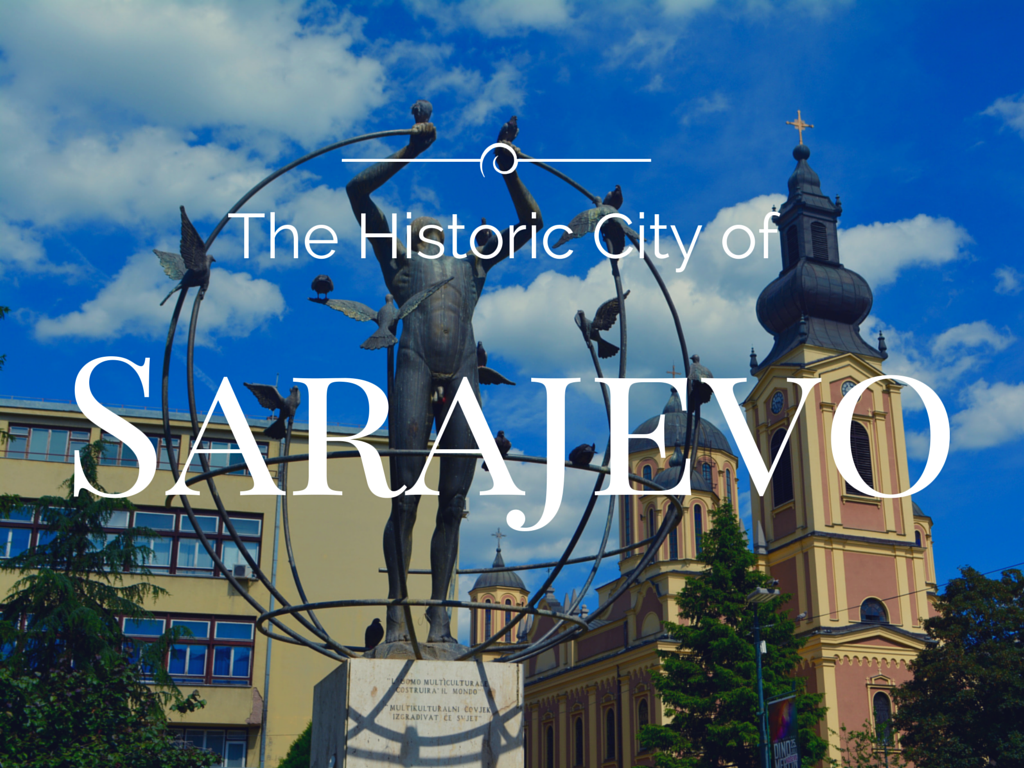If you’re planning on visiting Sarajevo, Bosnia I Herzegovina, there’s no second guessing that you’re going to be diving into a whole load of historical adventures.
From the moment you wake up, to the second you fall asleep, the history of Sarajevo will be all around you. I say this more in a hypothetical manner… unless you’re staying at the Franz Ferdinand Hostel (which I would highly recommend).
For the first time in my life I was actually happy to switch rooms over the course of two nights, not because there were terrible snoring beasts or loud obnoxious partiers… but because each and every single room has a little bit of history to teach you while you’re tucking into bed.

Photo Taken from Franz Ferdinand Hostel
So in order to get you ready for a trip to Sarajevo, it’s pretty obvious that you’ll need a little itty bit of a history lessons before heading onward (though the Franz is a great start)!
A Chronological History of Events in Sarajevo
1908: Bosnia I Herzegovina was taken over by the Austria-Hungarian Empire.
1914: Gavrilo Princip assassinates Franz Ferdinand whom was the Austrian archduke.
In July, the assassination lead to a brutal battle – World War One
1918: In November, World War One comes to an end. Result – more than 9 million soldiers and 7 million citizens dead.
The Austria-Hungarian Empire is no longer and Bosnia-Herzegovina has now been deemed part of the Kingdom of Yugoslavia (Serbia, Croatia, Slovenia).
1941: Bosnia I Herzegovina is taken under control by the Nazi parties and all those who were pro-Hitler. During this year there were thousands dead including local Yugoslavs and imprisoned Jewish.
The communists of Yugoslavia run by the power of Josip Broz Tito now develop their own resistance group known as the Partisans (or the National Liberation Army) against the Nazis.
1945: The Partisans (National Liberation Army) see success in their battle and have now become the Yugoslav Socialist Federation (some of which were the countries most famous writers and artists).
1990: The fall of communism takes place across Yugoslavia. During the uproar of many political battles between the Yugoslavs, the Kingdom of Yugoslavia falls apart.
1991: Bosnia I Herzegovina calls for independence and now faces strain between those who believe they own the rights to Bosnia (mainly Serbs and Croats) and those who who born and raised Muslim Bosniaks.
1992: April 6th is the beginning of the Bosnian War. The Bosniaks and Croatians form an alliance to call independence of Bosnia and beat out Serbia.
Serbia takes strong control and then calls siege on Sarajevo now lining the entire city with machine guns and weaponry. This siege lasted 44 months. The idea is that the more pain inflicted on Sarajevo citizens, the more likely the Bosniaks will obey the Serbs demands.
1993: Croats step back and avoid fighting against the Serbs and choose to take over the territory still under reign by the Bosnian army troops. The idea was to separate Bosnia from Herzegovina, thus destroying the old bridge of Mostar, Bosnia I Herzegovina.
Conflict rises and alliances are formed across Bosnia. Bosnian Muslims come together with Croats in Herzegovina and Croats and Serbs come together in central Bosnia to fight again the Bosniaks.
United Nations offers safety camps for the Bosnian Muslims in the following cities: Sarajevo, Srebrenica and Gorazde.
1995: In July of 1995 more than 8,000 Bosniaks were killed. This is now known as the Srebrenica Genocide (or massacre).
The Dayton Peace agreement comes in and successfully ends the war in November of 1995.
1996 – onward: Government authorities across the globe begin to convict those involved with murder and brutality. Many sentenced to death or life in prison.
2004: EU peacekeepers are handed the authority by Nato. The same year the old bridge of Mostar is rebuilt and opened with a celebration.
Though still a recent and devastating history for not only those from Bosnia I Herzegovina but across the world, Sarajevo is certainly one of those places that can tell you much more about history than any lesson book.
Which is what leads me to write this:
Despite what critics may tell you, Bosnia is a safe place to visit and an extremely educational destination. Don’t let history stop you from embracing the future.
Before visiting to Sarajevo I got so much lash back from people online and along my travels. I was constantly asked why I would ever choose to travel to a city that still looks like a war zone or why a city as dirty as Sarajevo would be on my list of destinations to explore. Please, look beyond what everyday people say and embrace what you find intriguing. Sarajevo was surely an emotional trip, but it was one in which has enlightened me and inspired me for future travel.
Disclosure: I was kindly hosted on this trip by Franz Ferdinand Hostel. As always thoughts and words are my own.













